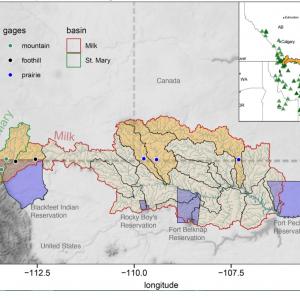The Future of International Waterways: The Milk and St. Mary River Basins Case Study
Date
foothills, feeding the Milk and St. Mary river basins, important regions to the Chippewa Cree Indians, Blackfeet, Assiniboine and Sioux Tribes. Besides providing crucial runoff to these downstream communities, the rivers also provide “critical water resources for agriculture, urban use, and support critical cold-water fisheries within the U.S. and Canada,” according to Greg Pederson (US Geological Survey). However, most of the existing natural streamflow records are pretty short, making it challenging to adequately characterize streamflow variability from those records alone.
In a time of climate change, the threat of drought looms every year here, prompting the need to investigate longer historical streamflow records, in order to guide state and federal managers on their future assessment of drought risk for the region. A new publication by USGS scientists at the Northern Rocky Mountain Science Center, Martin and Pederson (2022) explores historical streamflow reconstructions from tree rings to gain insight into streamflow variability and drought in the region. While Dustbowl drought impacts were significant for the region in the 1930s, drought in the early 2000s surpassed even those deficits. Interestingly, lower elevation prairies were found to be considerably more sensitive to temperature variability than the mountain headwaters. The reconstructed streamflow records indicated that the more recent drought period of 2000 – 2010 was “probably the driest in the paleorecord over the prairies and occurred during a period where temperatures were probably exceeding any seen over the region in at least the last 1200 years,” says Justin Martin, co-author of the study.
On the current global emissions trajectory, the future looks much warmer which will drive important changes in seasonality across the region. What this means is that earlier melt-out of the snowpack from the winter will result in a longer warm season. Looking far out ahead, to the year 2100, droughts are likely to become increasingly severe and perhaps more frequent due to the effects of warming temperature alone. However, Pederson says, “there will be many surprises along the way to 2100 and, coupled with the unknown amount of future greenhouse gas emissions to be released or mitigated, it's difficult to project specific impacts with confidence that far into the future.” What we do know is that already scarce water resources will need to be increasingly carefully managed, especially in a region with a number of different stakeholders and the recent development of Tribal water rights.


